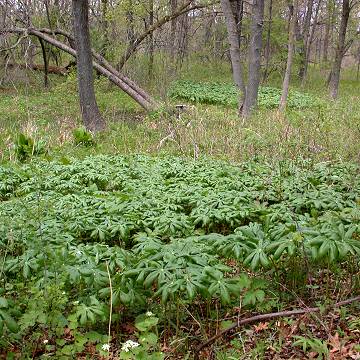

Podophyllum peltatum - (image 1 of 7)
Taxonomy
Family: Berberidaceae
Habitat
Woodlands. Can persist on exposed sites where the tree cover has been removed.
Associates
In woodlands with Acer saccharum, Fraxinus americana, Ostrya virginiana, Parthenocissus quinquefolia, Prunus serotina, Prunus virginiana, Quercus alba, Quercus rubra, Ribes missouriense, Tilia americana, Vitis riparia. Herbaceous associates include Allium tricoccum, Claytonia virginica, Cryptotaenia canadensis, Erythromium albidum, Glalium aparine, Galium concinnum, Geranium maculatum, Hydrophyllum virginianum, Osmorhiza claytonii, Phlox divaricata, Trillium recurvatum, Viola pubescens.
Distribution
Most of the eastern half of the U.S.
Morphology
Herbaceous perennial from a creeping rootstock. Leaves basal, solitary or paired, to 1' wide, deeply palmately lobed, the lobes oblong, umbrella-like. Flowers white, borne on long peduncles from the axis of two leaves, to 1" wide; sepals 4; petals 8.
Notes
Flowers early May to early June
Wetland indicator: Facultative Upland
Often forms large, circular, vegetative colonies. The fruit turns pale yellow when ripe and is said to be edible, possibly cathartic if unripe. It is usually difficult to find one that is fully ripe. The flavor isn't all that exciting, like a bland lemon.
References
Niering, W. A. 1979. The Audubon society field guide to North American
wildflowers: eastern region.
Knopf/Random House, New York.
Swink, F. and G. Wilhelm. 1994. Plants of the Chicago Region.
Indiana Academy of Science. The Morton Arboretum. Lisle, Illinois.
|
Michael Hough © 2005 |